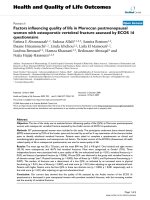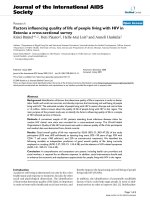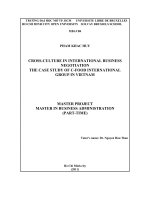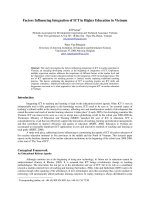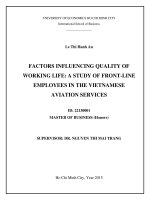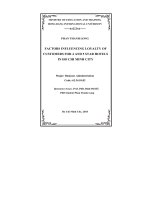Graduation thesis international business economics factors influencing choices of using third party logistics service providers of manufacturing companies in ho chi minh city
Bạn đang xem bản rút gọn của tài liệu. Xem và tải ngay bản đầy đủ của tài liệu tại đây (1.7 MB, 149 trang )
FOREIGN TRADE UNIVERSITY
HO CHI MINH CITY CAMPUS
---------***---------
GRADUATION THESIS
Major: International Business Economics
FACTORS INFLUENCING CHOICES OF USING
THIRD-PARTY LOGISTICS SERVICE PROVIDERS
OF MANUFACTURING COMPANIES IN HO CHI
MINH CITY
Author: Nguyễn Việt Hưng
Student ID: 1501015192
Class: K54CLC3
Supervisor: Nguyễn Thị Thu Hà (Assoc. Prof.)
Ho Chi Minh City, May 2019
TABLE OF CONTENTS
LIST OF ABBREVIATIONS
LIST OF FIGURES
LIST OF TABLES
PREFACE
1
CHAPTER 1: INTRODUCTION TO FACTORS INFLUENCING CHOICES
OF USING THIRD-PARTY LOGISTICS SERVICE PROVIDERS OF
MANUFACTURING COMPANIES IN HO CHI MINH
2
1.1. The necessity of the research
2
1.2. Literature review
5
1.2.1. International research
5
1.2.2. Domestic research
7
1.3. Research objectives
7
1.4. Subject and scopes of the research
8
1.5. Research methodology
9
1.6. New contribution of the research
9
1.7. Research structure
10
CHAPTER 2: THEORETICAL BASIS AND RESEARCH MODELS OF
FACTORS
INFLUENCING
CHOICES
OF
USING
THIRD-PARTY
LOGISTICS SERVICE PROVIDERS OF MANUFACTURING COMPANIES
IN HO CHI MINH CITY
11
2.1. Overview of third-party logistics service provider
11
2.1.1. Definition of third-party logistics
11
2.1.2. The role of third-party logistics in supply chain of manufacturing companies
12
2.1.3. Types of services offered by third-party logistics service provider
14
2.2. Theoretical basis for factors influencing choices of using third-party
logistics services of manufacturing companies in Ho Chi Minh city
17
2.2.1. Transaction-cost economics by Oliver E. Williamson (1979)
17
2.2.2. A model for strategic supplier selection by Joseph Sarkis and Srinivas Talluri
(2002)
18
2.2.3. The five-stage model of third-party logistics buying process by Harry Sink
and John Langley Jr. (1997)
19
2.3. Previous empirical researches on factors influencing choices of using
third-party logistics of manufacturing companies
22
2.3.1. Selection of Third-Party Logistics (3PL): A hybrid approach using
interpretive structural modeling (ISM) and analytic network process (ANP) by
Jitesh Thakkar and associates (2005)
22
2.3.2. A framework for evaluating third-party logistics by Ganesh Vaidyanathan
(2005)
25
2.3.3. Applying analytic network process (ANP) in logistics service provider
selection – a case study of the industry investing in Southeast Asia by Kai-Ying
Chen and Wan-Ting Wu (2011)
29
2.3.4. 3PL selection criteria in integrated circuit manufacturing industry in Taiwan
by Bang-Ning Hwang, Tsai-Ti Chen, and James T. Lin (2016)
2.3.5. Summary of factors in related empirical research
31
33
CHAPTER 3: RESEARCH MODELS ON FACTORS INFLUENCING
CHOICES OF USING THIRD-PARTY LOGISTICS SERVICE PROVIDERS
OF MANUFACTURING COMPANIES IN HO CHI MINH CITY
35
3.1. Research process
35
3.2. Preliminary research methodology
36
3.2.1. Proposed research model and research hypotheses
36
3.3. Official research methodology
40
3.3.1. Method of collecting information and determining sample size
40
3.3.2. Method of data analysis
41
3.4. Scale of measurement for each variable
44
3.4.1. The measurement scale for performance factor
44
3.4.2. The measurement scale for service factor
45
3.4.3. The measurement scale for cost factor
45
3.4.4. The measurement scale for quality assurance factor
45
3.4.5. The measurement scale for IT factor
46
3.4.6. The measurement scale for intangibles factor
46
3.4.7. The measurement scale for dependent variables
47
CHAPTER 4: RESEARCH OUTCOMES AND DISCUSSION ON FACTORS
INFLUENCING CHOICES OF USING THIRD-PARTY LOGISTICS
SERVICE PROVIDERS OF MANUFACTURING COMPANIES IN HO CHI
MINH CITY
48
4.1. Research outcomes description
48
4.1.1. Official sample description
48
4.1.2. Cronbach’s Alpha coefficient of reliability analysis
50
4.1.3. Exploratory factor analysis
54
4.1.4. Adjusted model after factor analysis
56
4.1.5. Multiple linear regression analysis
56
4.1.6. Detecting violations of regression assumptions
60
4.1.7. Testing model hypotheses
62
4.1.8. ANOVA result analysis
63
4.2. Research outcomes discussion
64
4.2.1. Performance factor
64
4.2.2. Service factor
64
4.2.3. Cost factor
65
4.2.4. Quality assurance factor
65
4.2.5. IT factor
66
CHAPTER 5: RECOMMENDATIONS FOR THIRD PARY LOGISTICS
SERVICE PROVIDERS OPERATING IN HO CHI MINH CITY
68
5.1. Potentials of the market for third-party logistics in Ho Chi Minh city
68
5.1.1. Opportunities
68
5.1.2. Challenges
69
5.2. Recommendations for third-party logistics operating in Ho Chi Minh City
71
5.2.1. Control cost and offer competitive price
71
5.2.2. Improve performance capability
74
5.2.3. Expand IT capability
76
5.3. Limitations of the research and directions for future research
78
CONCLUSION
80
LIST OF REFERENCES
81
APPENDIX
89
LIST OF ABBREVIATIONS
Abbreviation
Meaning
3PL
Third-party logistics
4PL
Fourth-party logistics
5PL
Fifth-party logistics
AHP
Analytical Hierarchy Process
ANP
Analytical network process
ANOVA
Analysis of variance
ASEAN
Association of Southeast Asian Nations
CAGR
Compound annual growth rate
CMR
Customer relationship management
DEMATEL
Decision making trial and evaluation laboratory
DTT
Delivery turnaround time
EBPS
Electronic bill payment solution
EDI
Electronic data interchange
EFA
Exploratory factor analysis
FAA
Federal aviation administration
FAHP
Fuzzy analytical hierarchy process
FDA
Food and drug administration
FTP
File transfer protocol
GDP
Gross domestic products
IC
Integrated circuit
ISM
Interpretive structural modeling
ISO
International organization for standardization
KMO
Kaiser-Meyer-Olkin
KPI
Key performance indicator
IT
Information technology
LPI
Logistics performance index
MNCs
Multinational corporations
SCM
Supply chain management
TEU
Twenty-foot equivalent unit
TOPSIS
Technique for Order of Preference by Similarity to Ideal Solution
USD
United States dollar
VND
Vietnam dong
VIF
Variance inflation factor
VPN
Virtual private network
XML
Extensible markup language
LIST OF FIGURES
Figure 1.1: LPI overperformers and underperformers
2
Figure 2.1: Relationship of 3PL provider in the supply chain of manufacturer
12
Figure 2.2: Summary of logistics activities in the supply chain
13
Figure 2.3: Detailed graphical representation for strategic supplier selection
18
Figure 2.4: The five stages of third-party logistics buying process
20
Figure 2.5: 3PL evaluation process
25
Figure 3.1: Research procedure
35
Figure 3.2: Proposed research model for the thesis
37
Figure 4.1: Scatterplot of standardized residuals
61
Figure 4.2: Histogram of residual frequency
61
LIST OF TABLES
Table 2.1: Classification of 3PL service providers based on type of activity
11
Table 2.2: Types of services offered by 3PL service providers
14
Table 2.3: Shipper views of needed IT-based capabilities by 3PLs
16
Table 2.4: 3PL service providers selection criteria
23
Table 2.5: Summary of classification of variables
24
Table 2.6: Performance, service and quality assurance criteria details
27
Table 2.7: Information technology, costs and intangibles criteria details
28
Table 2.8: Dimensions and criteria for 3PL selection by Chen and Wu
29
Table 2.9: Summary of factors in previous empirical research
33
Table 3.1: Five-point Likert Scale
36
Table 3.2: Measurement scale for performance factor
44
Table 3.3: The measurement scale for service factor
45
Table 3.4: The measurement scale for cost factor
45
Table 3.5: The measurement scale for quality assurance factor
46
Table 3.6: The measurement scale for IT factor
46
Table 3.7: The measurement scale for intangibles factor
47
Table 3.8: The measurement scale for dependent variables
47
Table 4.1: Data collection results
48
Table 4.2: Demographic characteristics of the respondents
49
Table 4.3: Cronbach’s Alpha for Performance factor
51
Table 4.4: Cronbach’s Alpha for remaining factors
52
Table 4.5: Cronbach’s Alpha for dependent variables
53
Table 4.6: Rotated component matrix
55
Table 4.7: Exploratory factor analysis for dependent variable
56
Table 4.8: Pearson correlations matrix
57
Table 4.9: Model summary
58
Table 4.10: ANOVA testing results
59
Table 4.11: Regression result
59
Table 4.12: Hypotheses testing results
62
1
PREFACE
First and foremost, the author would like to send his utmost regards to the
lecturers of Foreign Trade University, Ho Chi Minh campus, who have been
accompanying the author on his 4 years here. The author is grateful for all the
experiences and guidance received at Foreign Trade University in Ho Chi Minh
city.
Secondly, the writer would like to give his sincere gratitude to his supervisor,
Mrs. Nguyen Thi Thu Ha (Ph.D.), for all her support and precious guidance, as well
as other lecturers who have assisted and instructed the author in this research work.
Without her support and dedicated involvement throughout the process, this thesis
would not be completed.
The author would also like to bestow his gratitude to all corporations who
provided him with the opportunities to contact and gain realistic information from
their employees and managers. Especially, without the dedication of respondents in
spending time and effort answering the questionnaire, the writer would not have
gained the most relevant assessment regarding the situation of the industry, as well
as perceptions and market analysis of industry insiders.
Finally, despite the time and effort invested in researching and completing the
paper, there remains inevitable errors due to the limitation in specialized knowledge
and experience. The author, thus, heartily welcomes all comments and contributions
for future improvements of the topic.
Ho Chi Minh City, May 2019
The author
Nguyễn Việt Hưng
2
CHAPTER 1:
INTRODUCTION TO FACTORS
INFLUENCING CHOICES OF USING THIRD-PARTY
LOGISTICS SERVICE PROVIDERS OF MANUFACTURING
COMPANIES IN HO CHI MINH
1.1. The necessity of the research
In-house or outsource for the supply chain has always been a critical strategy
of the key decision makers of an organization. Each side has its advantages and
incurred risks associated. At the same time, the state of the market has pushed the
relevancy of supply chain to the forefront more than ever, thanks to the growth of
buying power, e-commerce, booming customer demands and the technology rate of
development. Especially for third-party logistics (3PL) service providers, the
competition has never been fiercer. As manufacturers shift focus to their own core
competencies, such as market share, product development, marketing, 3PLs
outsourcing is an inevitable choice for securing a strong supply chain to the
business.
Global 3PL market size analysis comments that the global market size is
estimated at USD 865 billion in 2018, with a CAGR of 9%. Asia Pacific is expected
to lead the global 3PL market not only in terms of value but also growth rate. The
growth in the region will be driven by huge amount of trade flow in China and
South East Asia. In tune with the trend of outsourcing logistics activities among
manufacturers, many Vietnamese enterprises agree that selecting the appropriate
third-party logistics service provider is becoming an increasing undisputed practice.
3
Figure
1.1: LPI overperformers and underperformers
Source: World Bank, 2018
Logistics activities in Vietnam is on the rise with the acceleration of import
and export activity. According to the bi-annual report from World Bank, Vietnam
places at 39 globally on the LPI (Logistics performance index), a 25 position
increase from 2016. The figure 1.1 illustrates the performance of countries of
similar income. The data suggests that Vietnam is an overperformer of this quartile.
Compared to countries from the same geological position, Vietnam places at
number 3 in ASEAN, preceded only by Singapore and Thailand.
The 2019 Agility emerging markets logistics index place Vietnam at the 10th
most promising logistics market, one spot higher than Thailand. The contract
logistics and domestic express markets of Vietnam are around 750 million USD in
value, accompanied by healthy growth rates. Port capacity of Vietnam stands at an
annual rate of 11 million TEU, and the sea freight market is estimated to grow at a
15.3% CAGR over the five years to 2022. About 90% of imports and exports into
Vietnam transport via sea with about 500-600 million tons / year. It is expected that
by 2020, goods through seaports will reach 1,1 billion tons. Vietnam also places 4th
in the international logistics opportunities sub-category. With the ongoing tension
between the U.S and China, a 56,1% of respondents say that South East Asia will
reap benefit.
4
In Vietnam, in 2018, logistics industry saw a 12-14% growth, due to the rise of
the entire economy as well as special attention and appropriate policies from the
Government. The industry reality shows that the world's highest revenue logistics
corporations are also the leading units in providing comprehensive package logistics
contracts. In Vietnam, this trend is similar, with foreign 3PL logistics providers
(currently the highest logistics business model in Vietnam) such as DHL Logistics,
Damco, FedEx, APL … being market-leading businesses thanks to the advantages
of equipment, management technology and additional value-added services. On the
other hand, Vietnam's exports are mainly processed goods, so the services related to
logistics provided to these export-producing enterprises are mainly undertaken by
foreign companies due to their concerns of domestics 3PLs.
Some Vietnamese logistics enterprises such as Tân Cảng Sài Gòn, Gemadept,
Vinafco and Transimex are actively developing 3PL service models and are strong
enterprises in terms of ownership of fixed assets and providing mechanical services.
copy. Currently, Vietnam logistics enterprises only meet 1/4 of logistics market
demand and are stopping to provide services for some initial stages of logistics
service chain, the service is still simple, not highly integrated, only a few large
logistics companies have a closed service chain. Vietnam logistics enterprises are
mainly small and medium-sized enterprises, providing unilateral supply services in
the territory of Vietnam such as forwarding services, packaging services,
warehousing and customs services. Meanwhile, internationally integrated services
are all provided by foreign logistics enterprises.
Vietnam actions towards improvement of logistics have been significant.
Changes in policies and procedures are the biggest upsides in the effort to promote
Vietnam logistics competitiveness. Also, infrastructure is more concerned, but it is
suggested that rate of development needs to be pushed for in 2019. Development
trend in logistics service supply in Vietnam will be the cooperation between
logistics enterprises to share profits from exploiting the advantages of infrastructure
and transport, as well as increasing the competitiveness to reach higher levels of
5
logistics services, aiming to provide 3PL, 4PL and 5PL services in the future, as
shown in the 2018 3PL study (Langley, 2018).
Acknowledging the necessity, especially in Ho Chi Minh City, the author
decided to conduct a research on the topic of “Factors influencing choices of using
third-party logistics service providers of manufacturing companies in Ho Chi
Minh city”. The topic does not only provide suggestions for 3PL service providers
in Ho Chi Minh city to improve their operations and customer services, but also
provide basis for further study of related issues surrounding the 3PL outsource
decisions of different types of firms as well. The author proposes a 3PL service
providers selection and evaluation model and focuses on manufacturing companies
operating in Ho Chi Minh city as the research subject. Through survey and
questionnaires, the author collects information to determine the key trends of
manufacturers when they look for a 3PL service provider. Analytical network
process method will be applied to deal with dependent problems and evaluate the
interdependence between criteria in quantitative approach. Insights will be
extracted, and solution will be suggested to assist decision makers in assessing the
relative ranking of logistics service providers.
1.2. Literature review
1.2.1. International research
Over the years, a greater amount of attention has been given to the selection of
a 3PL provider. Few studies have been devoted to identifying 3PL selection criteria
in the literature, including, Meade and Sarkis (2002) Bottani and Rizzi, (2006);
Bagchi and Mitra (2006); McGinnis et al., (1995); Qureshi et al., (2008); Jharkharia
and Shankar, (2007); Yan et al. (2003; Langley (2004). Below is a summary of
some significant researches to the author in order of time of release.
In a study, “Selection criteria for providers of third-party logistics services: an
exploratory study”, by Menon et al. (1998), “on-time shipments and deliveries”,
“meet/exceed promises”, “availability of top management support”, “error rates”,
“responsiveness”, “creative management”, “financial stability” and “meet
6
performance/quality requirements” were identified as the criteria for selecting 3PL
service providers.
Onto the 21st century, a study, “A framework for evaluating third-party
logistics”, by Vaidyanathan (2005) provided a comprehensive framework with a set
of factors that can be used to evaluate a 3PL service provider. This includes 5
factors: “information technology”, “quality”, “cost”, “services”, “performance,
intangibles”.
In another study by Thakkar et al. (2005), “Selection of third-party logistics
(3PL): a hybrid approach using interpretive structural modeling (ISM) and analytic
network process (ANP)”, a list of 15 criteria for the 3PL selection were identified,
namely: “sound financial background”, “previous experience”, “trained logistics
personnel”, “readiness to work under the brand name of contract giving
organisation”, “necessary certifications”, “readiness to enter into a long-term
contract”,
“geographical
coverage”,
“proactiveness
in
system
design”,
“trustworthiness”, “attitude toward open-book accounting”, “readiness to work
under a computerised system”, “flexibility”, “margins provided to contractor”, and
“attitude toward hygienic practices”.
In their research paper “A fuzzy TOPSIS methodology to support outsourcing
of logistics services”, Bottani and Rizzi (2006) proposed 12 factors for their model.
They are “breadth of service”, “business experience”, “characterization of service”,
“compatibility”, “financial stability”, “flexibility of service”, “performance”,
“price”, “physical equipment and information systems”, “quality”, “strategic
attitude”, “trust and fairness”.
From the paper “An integrated model to identify and classify the key criteria
and their role in the assessment of 3PL services providers”, Qureshi et al. (2008)
suggested ten criteria, including: “IT capability”, “flexibility”, “quality of
management”, “financial stability”, “compatibility”, “reputation”, “long-term
relationship”, “surge capacity”, “size and quality of assets”, and “geographical
reach and range of service”.
7
In their research “FAHP sensitivity analysis for selection of third-party
logistics (3PL) service providers”, Kasture et al. (2008) considered five major
criteria, when choosing the 3PL service provider including “logistics capability”,
“logistics service quality”, “logistics information capacity”, “potential for
development” and flexibility”. For each major factor, sub-factors were included. For
instance, logistics throughput capability, technology capacity, equipment capacity,
and maintenance cost were included under the logistics capability factor.
Chen and Wu (2011) in their research “Applying analytic network process in
logistics service provider section – A case study of the industry investing in
Southeast Asia” considered numerous factors for logistics provider selection for
electronic companies in Southeast Asia. Amongst those factors was “price”,
“enhanced
operational
efficiency”,
“delivery
performance”,
“flexibility”,
“developing long-term relationships”, “financial conditions”, “industry reputation”,
“employee performance”, “on-time delivery”, and “surge capability”.
Govindan et al (2016) in their research “A grey DEMATEL approach to
develop third-party logistics provider selection criteria” approached the problem by
applying grey decision-making trial and evaluation laboratory (DEMATEL). His set
of factor consists of “service quality”, “on time delivery performance”, “flexibility
in operation”, “cost of services”, “customer service”, “logistics information
system”, “financial stability”, “reputation”, “geographic location”, “technological
capability”, “performance history”, and “human resource policies.”
In the literature review papers on criteria and method used in the 3PL service
providers selection topic in 2014, Aicha Aguezzoul pointed out, through analysis of
67 articles on 3PL selection, some interesting statistics on the criteria of this topic.
The most commonly used criteria are: “cost”, “relationship”, “services”, “quality”,
“information/equipment system”, “flexibility and delivery”, represent 79,59% of
criteria. The other 20,41% of criteria are “professionalism”, “financial position”,
“location”, and “reputation”.
8
1.2.2. Domestic research
In Vietnam, there are several researches dedicated to this decision. Below are
some of the prominent and recent research of the topic.
Le Tan Buu and Dang Nguyen Tat Thanh (2014) from University of
Economics Ho Chi Minh proposed a model to investigate the factors influencing the
selection of logistics providers in Ho Chi Minh city in his master thesis, “Các tiêu
chí cốt lõi ảnh hưởng đến quyết định lựa chọn nhà cung cấp dịch vụ logistics tại
thành phố Hồ Chí Minh”, with the scales to measured based on Parasuraman (1988)
and Ruth and Nucharee (2011). They suggested six factors, which are
“responsiveness”, “quality assurance”, “reliability”, “empathy”, “tangibles”, and
“price”.
Hoang Quoc Huy (2016), with his graduation thesis “Nghiên cứu các yếu tố
ảnh hưởng đến quyết định lựa chọn dịch vụ logistics của khách hàng tổ chức tại
công ty tnhh đầu tư thương mại vận tải Thái Dương, Hải Phòng” has concluded on
five factors. They are “reliability”, “responsiveness”, “IT systems”, “price”, and
“brand image”.
1.3. Research objectives
In accordance with the findings above, this study is executed based on these
following objectives:
❖ Firstly, the author aims to clarify the transaction cost economics in
general, the strategic supplier selection and theory of 3PL service
providers selection.
❖ Secondly, the author conducts in-depth study on factors influencing
choices of 3PL service providers by referring to previous empirical
researches regarding the topic, therefrom proposing the model and
hypotheses for the topic.
❖ Thirdly, the author estimates the influence of the factors by conducting
preliminary survey, then conduct the official research by distributing
online and offline questionnaires and analyze the results.
9
❖ Finally, with the conclusions from preceding chapters, the writer
presents advantages and disadvantages in Ho Chi Minh City market for
3PL service providers; offers suggestions for these organizations to
come up with the most suitable business strategies, which may result in
a rise in profits by enhancing recent customer’s satisfaction, as well as
attracting new customers.
1.4. Subject and scopes of the research
The subject of this research is that factors that significantly impact the choice
of 3PL service providers of manufacturing companies in Ho Chi Minh City.
For the scopes of the research, regarding the content of this research, the
writer only investigates the subjective viewpoints of manufacturing companies in
Vietnam due to limitation in time and resources.
Scope of this research in terms of geographical location is limited to
manufacturing companies which operate in Ho Chi Minh City, being the recent
customers 3PL service providers. The reason for choosing Ho Chi Minh City is
based on its performance as the driver of the country. Ho Chi Minh city continues to
be the leading region in economics performance of Vietnam in 2018, attributing to
24,16% of the total outcome of Vietnam. In terms of sea transport, along with Vung
Tau, Hai Phong, Quang Ninh, goods going through ports of these city range from
19,57 to 25,4 million tones, according to Vietnam Maritime Administration. Also,
35%-40% of containers comes from ports of Ho Chi Minh, while 90% of containers
are transported between Ho Chi Minh city and ports. Ho Chi Minh city is
considered an emerging logistics center of Asia.
For time scope, the research about the topic of “Factors influencing choices of
using third-party logistics service providers of manufacturing companies in Ho Chi
Minh city” is conducted within the period of 4 months from February 2019 to May
2019, in which the survey will be carried out in March and April. The time scope is
chosen based on the result of Vietnam logistics report (Ministry of Industry &
Trade, 2018), in which 73% of logistics firms asked says that the industry will see a
two-digit increase in 2019. The other 23% agrees that the growth will be below 10%
10
and no negative answers received. The logistics industry is visioning a positive
outlook for 2019, and this research will help 3PL service providers identify the
needs of the customers to achieve the expected results.
1.5. Research methodology
The writer uses the analysis and synthesis qualitative research method, with
the first step is collecting primary and secondary data. Primary information is
obtained through in-depth interviews with experts and survey distribution to
manufacturers in Ho Chi Minh City. The information is then processed and
analyzed with regression analysis. Meanwhile, secondary data is collected from
official and reliable sources domestically and globally. Textbooks, official journals,
researches, newspaper articles, reports and data collected by General Statistics
Office of Vietnam and other authorities and agencies in Vietnam are utilized.
Secondly, the processing of collected data starts with amendments to the
questionnaires after acquiring insights from industry insiders. After the official
research, Microsoft Excel is used to eliminate inappropriate responses from the
primary information. Subsequently, the author uses IBM SPSS Statistics 20
software to get the desired results. Cronbach’s Alpha coefficient of reliability test is
carried out, followed by exploratory factor analysis. The purpose is to evaluate the
validity of the measured variables and independent variables on the choice of 3PL
service providers.
Lastly, the author uses multiple linear regression analysis to figure out the
significance of the proposed hypotheses. The results are analyzed to determine the
importance as well as the level of influence of each factor on manufacturer’s choice.
1.6. New contribution of the research
First and foremost, despite the growth of the 3PL market of Vietnam, the
number of researches regarding the topics are surprisingly insignificant. Therefore,
the study will give a different point of view of the problem in choosing 3PL service
providers. Secondly, the available studies regarding the choice of 3PL service
providers yield varied results. Additionally, demographics of Vietnamese
manufacturing companies are different from their counterparts from developed
11
countries, thus the findings from foreign studies cannot be directly applied to the
economic situation of Vietnam. Thirdly, the industry outlook for logistics changes
by the year, that is why this study is needed to provide updated point of view of
manufacturers to their choices.
This research will propose a new insight into how 3PL service providers can
effectively operate in Vietnam market, as well as provide them a more local
perspective by presenting specific factors influencing Vietnamese’s manufacturers
in the strategic decision-making.
1.7. Research structure
This graduation thesis is constructed with five chapters:
Chapter one: Introduction to factors influencing choices of using third-party
logistics service providers of manufacturing companies in Ho Chi Minh city
Chapter two: Theoretical basis and research models of factors influencing
choices of using third-party logistics service providers of manufacturing companies
in Ho Chi Minh city
Chapter three: Research models on factors influencing choices of using
third-party logistics service providers of manufacturing companies in Ho Chi Minh
city
Chapter four: Research outcomes and discussion on factors influencing
choices of using third-party logistics service providers of manufacturing companies
in Ho Chi Minh city
Chapter five: Recommendations for third party logistics service providers
operating in Ho Chi Minh city
Summary of chapter 1
In the first chapter, the author overviews the information on the decision to
pursue the topic and the overall structure of the thesis. Then, through the literature
review on the matter of selection and evaluation of 3PL service providers, the
author points out his expected contributions to the topic, with hopes to provide new
insights fitting the economic overview of Vietnam, and Ho Chi Minh city.
12
In the next chapter, the author discusses the theoretical basis and reviews
prominent researches on the topic of selection of 3PL service providers of
manufacturing companies.
13
CHAPTER 2:
THEORETICAL BASIS AND RESEARCH
MODELS OF FACTORS INFLUENCING CHOICES OF
USING THIRD-PARTY LOGISTICS SERVICE PROVIDERS
OF MANUFACTURING COMPANIES IN HO CHI MINH
CITY
2.1. Overview of third-party logistics service
provider
2.1.1. Definition of third-party logistics
Firstly, the author goes over definitions of other authors. Some define 3PL by
granting it with a large scope of activities. McGinnis et al (1995) define 3PL
activities as logistical activities that can be provided or required by either a buyer or
a seller. Another definition of 3PL characterizes it as an external organization that
performs all or part of a producer's or consumer's logistical functions (Coyle et al,
2003). By contrast, Murphy and Poist (1998) propose a narrower and more
exclusive definition of 3PL, saying that it is a long-term, mutually beneficial
alliance between a shipper and a logistics provider that offers various logistics
service and functions. Similarly, Bagchi and Virum (1996) refer to 3PL as a
long-term partner that provides all or a considerable number of logistics activities
for the shipper. From the given definitions, the author agrees with the opinion that
3PL is a long-term partner to the manufacturer, whose relationship goes beyond the
usual transaction basis towards a win-win situation that both parties can prosper.
Currently, 3PL service providers can be divided by the types of activities they
offer (Coyle et al., 2003). Table 2.1 shows the type of and examples of 3PL
providers.
Table 2.1: Classification of 3PL service
providers based on type of activity
Type
Examples
Transportation based
Damco, VN post, GHN, GHTK, FedEx, UPS
Distribution based
DHL, Damco, Vinalines, Vinafco
